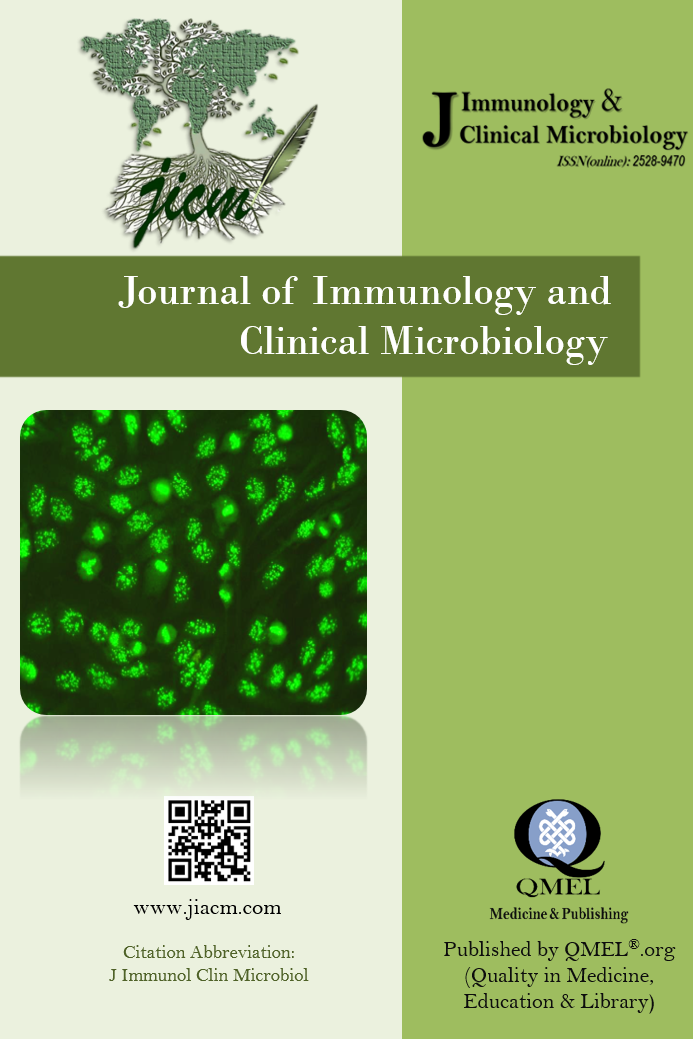Eikenella corrodens’e bağlı skrotal apse : Olgu Raporu
Eikenella corrodens (E.corrodens) orofarenks, gastrointestinal ve genitoüriner sistem floralarında yer alan fakültatif anaerobik Gram negatif bir basil olup fırsatçı bir patojendir. Daha çok insan ısırığı ile ilişkilendirilen E.corrodens son zamanlarda akciğer başta olmak üzere farklı bölgelerde enfeksiyona sebeb olmaktadır. Bu olgu raporunda ülkemizde şu ana kadar hiç bildirimi yapılmamış olan E. corrodens’e bağlı gelişen skrotal apse vakasının sunulması amaçlanmıştır. Bakımevinde yaşayan mental retarde 33 yaşında erkek hasta hafif ateş, sol skrotal bölgede şişlik ve akıntı şikayeti ile acil servisimize başvurdu. Değerlendirmesi yapılan hastanın Üroloji konsültasyonunda skrotal apseden Gram Boyama ve kültür istemi yapıldı. Aynı zamanda hastaya ampirik olarak seftriakson tedavisi başlandı. Yapılan Gram boyamada lökosit ve az sayıda Gram negatif basil görüldü. Skrotal apse kültüründe ise 48 saat sonrasında EMB besiyerinde üreme olmazken Kanlı ve Çukulata agar besiyerinde küçük, grimsi kolonilerin ürediği saptandı. Konvansiyonel mikrobiyolojik yöntemler ve VITEK® 2 Compact otomatize sistem (BioMérieux, France) ile yapılan identifikasyon sonucu E.corrodens izole edildi. Antimikrobiyal duyarlılık sonucu seftiriakson tedavisinin devamına karar verildi. Apse drenajı ve antibiyotik tedavisinden sonra hasta şikayetlerinde gerileme olması üzerine seftriakson tedavisi 7 güne tamamlanan hasta şifa ile taburcu edildi. E.corrodens temelde iyi klinik göstermesinin yanında invaziv enfeksiyonlara ilerleyebilen ve vücudun herhangi bir bölgesinde apse oluşumuna neden olabilen fırsatçı bir patojendir. İmmunsistemi baskılanmış, bir nedenle özbakımı tam olmayan hastalarda vücudun herhangi bir yerinde oluşan enfeksiyonlarda ve skrotal bölgede şişlik, kızarıklık ve akıntı semptomlarının eşlik ettiği skrotal apse vakalarında etken olabileceği akılda tutulmalıdır.
Anahtar Kelimeler:
Eikenella corrodens
Eikenella corrodens caused scrotal abscess: A case report
Eikenella corrodens (E.corrodens)D is a facultative and opportunistic pathogen that is part of the microflora occupying the oropharyngeal, gastrointestinal, and genitourinary systems. It is mainly associated with human bites and lately, it has been shown that it causes infections in the lungs and other sites. In this case report, we show for the first time that E.corrodens can The patient was 33 years old male living in a nursing home due to mental retardation. He presented with mild fever, swelling of the left scrotal area, and discharge on admission to the emergency department. After urologic consultation, Gram and culture testing of the abscess were requested. At the same time, the patient underwent empirical therapy with ceftriaxone. Gram staining revealed leukocytes and low numbers of Gram-negative bacilli. Culturing for 48 hours in EMB media proved negative for growth but small grayish colonies appeared in blood and chocolate agar.. As a result of conventional microscopic and VITEK®2 automated system investigations, E.corrodens was isolated. The results of the antibiotic sensitivity tests supported the continuation of therapy with ceftriaxone. As a result of abscess draining and antibiotic treatment, the symptoms waned and the patient was discharged after 7 days. E.corrodens can cause invasive infections as well as abscesses in different sites of the body. E.corrodens can cause abscess formation accompanied by swelling, redness, and discharge in any area of the body where it resides including the scrotal region in those with immunosuppressive states including poor self-care.
Keywords:
Eikenella corrodens;, opportunist pathogen scrotal abscess,
___
- 1. Aygun D, Akdeniz B, Aygun G, Cokugras H, Camcıoglu Y. Thyroid abscess due to Eikenella corrodens in a pediatric patient. J Infect Dev Ctries. 2019;13(10):945-947. doi:10.3855/jidc.11057
- 2. Yakut N, Kepenekli Kadayıfçı E, Karaaslan A, et al. Deep Neck Infection Caused by Eikenella Corrodens Coinfection with Streptococcus Mitis and Streptococcus Oralis in an Infant. Turkish J Pediatr Dis. 2016;(5):2016-2018. doi:10.12956/tjpd.2016.227
- 3. Nordholm AC, Vøgg ROB, Permin H, Katzenstein T. Eikenella corrodens endocarditis and liver abscess in a previously healthy male, a case report. BMC Infect Dis. 2018;18(1):1-5. doi:10.1186/s12879-018-2949-4
- 4. Sula B, Tekin R. Soft Tissue Abscess due to Eikenella corrodens after Human Bite. J Microbiol Infect Dis. 2016;6(01):36-37. doi:10.5799/ahinjs.02.2016.01.0212
- 5. Rodríguez-Rojas L, Suarez-López A, Cantón R, Ruiz-Garbajosa P. Eikenella corrodens causing deep-seated infections. Six-year experience in a University Hospital in Madrid. Enfermedades Infecc y Microbiol Clin (English ed). 2020;38(2):76-78. doi:10.1016/j.eimce.2019.04.020
- 6. Hombach M, Frey HR, Pfyffer GE. Urinary tract infection caused by Eikenella corrodens. J Clin Microbiol. 2007;45(2):675. doi:10.1128/JCM.02194-06
- 7. Alpaslan M, Dundar I, Durmaz F, Arslan H, Batur A. Hidradenitis Suppurativa Accompanying Crohn’s Disease with Multifocal Abscess. Van Med J. 2016; 23(2): 225-2288.
- 8. Sane SM, Faerber EN, Belani KK. Respiratory foreign bodies and Eikenella corrodens brain abscess in two children. Pediatr Radiol. 1999;29(5):327-330. doi:10.1007/s002470050600
- 9. Sheng WS, Hsueh PR, Hung CC, Teng LJ, Chen YC, Luh KT. Clinical features of patients with invasive Eikenella corrodens infections and microbiological characteristics of the causative isolates. Eur J Clin Microbiol Infect Dis. 2001;20(4):231-236. doi:10.1007/PL00011259
- 10. Mühlhauser M. Eikenella corrodens. Rev Chil Infectol. 2013;30(2):163-164. doi:10.4067/S0716-10182013000200007
- 11. Yoshino Y, Inamo Y, Fuchigami T, et al. A pediatric patient with acute suppurative thyroiditis caused by Eikenella corrodens. J Infect Chemother. 2010;16(5):353-355. doi:10.1007/s10156-010-0063-7
- 12. Tanaka M, Araki K, Higuchi H, Fukuoka-Araki K, Horikoshi Y, Hataya H. Pediatric acute dacryocystitis due to Eikenella corrodens: A case report. J Infect Chemother. 2020;26(5):510-512. doi:10.1016/j.jiac.2019.12.014
- 13. Bahçeci İ. Microorganisms that Reproduce in Wound Cultures in Rize Region and Their Antimicrobial Susceptibility. Middle Black Sea Journal of Health Science. 2020; 6(3): 358-368.
- Yayın Aralığı: Yılda 4 Sayı
- Başlangıç: 2016
- Yayıncı: Erkan YULA
Sayıdaki Diğer Makaleler
Selçuk KAYA, Merve ZEREY ALBAYRAK, İlhan AFŞAR, Ayşegül AKSOY GÖKMEN, Aslı Gamze ŞENER
Eikenella corrodens’e bağlı skrotal apse : Olgu Raporu
İlkay BAHÇECİ, Duygu AKSOY, Ömer Faruk DURAN, Esra KARACA
Fusarium Solani’ye Bağlı Miks Onikomikoz Olgusu
Melek TİKVEŞLİ, Saban GURCAN, Erkut AFYONCU, Yıldız GÜRSEL ÜRÜN, Sezgi SARIKAYA SOLAK
